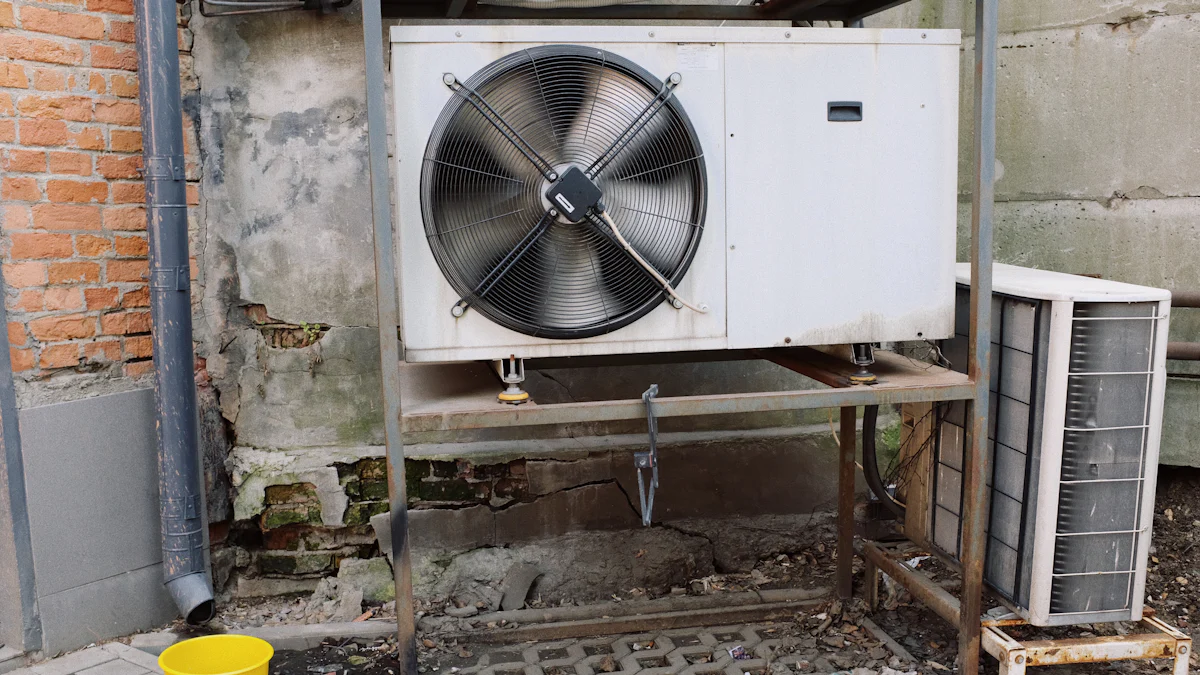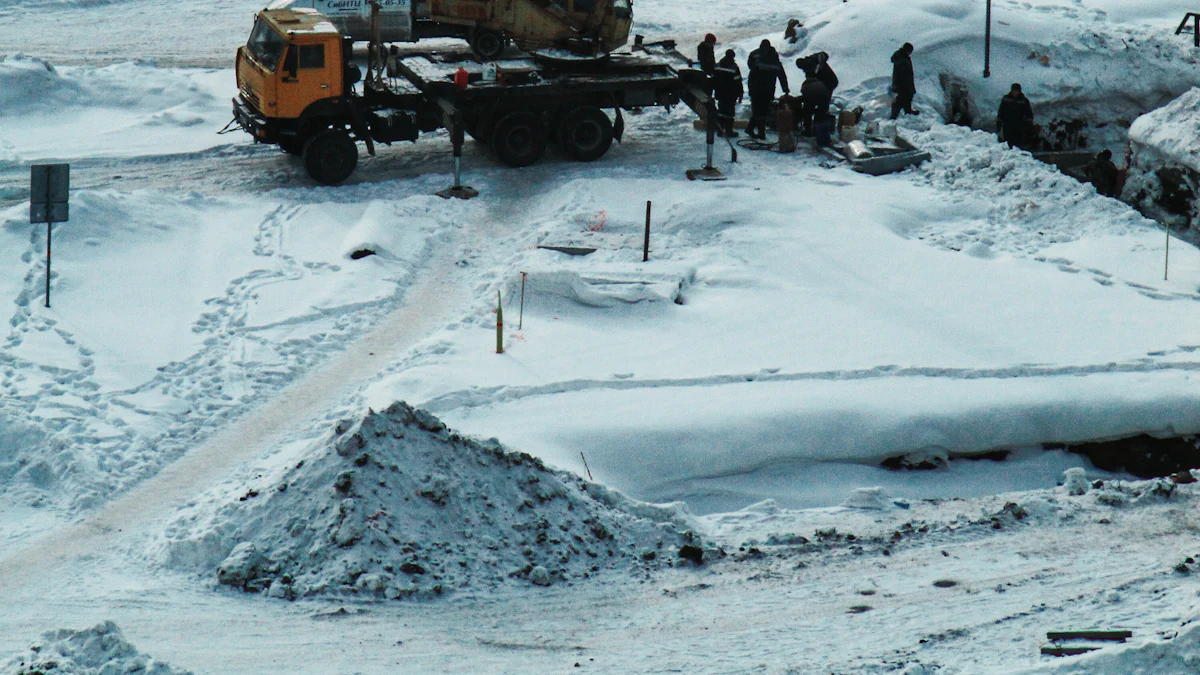Top 5 Rapid Freezing Systems for Industrial Applications

Choosing the right rapid freezing system is crucial for industrial success. These systems bring significant advantages to your operations. They enhance food safety by slowing bacterial growth and extend shelf life by delaying spoilage. The rapid freezing process preserves product quality by forming smaller ice crystals, which maintain texture and nutritional value. You also benefit from reduced processing times and energy costs, boosting productivity. High-quality frozen products stand out in the market, helping you build consumer trust. With these benefits, rapid freezing becomes a game-changer for industries aiming to optimize efficiency and quality.
Key Takeaways
Rapid freezing systems keep food safe by stopping bacteria growth. They also make food last longer, which helps with storage.
Cryogenic freezing uses very cold temperatures to stop big ice crystals. This keeps food's texture and nutrients the same.
Blast freezing systems save energy and can handle big jobs. They are great for freezing lots of food while keeping it fresh.
Plate freezing is small and cools food evenly. It works well for flat or packed items.
Tunnel freezing systems freeze food fast on moving belts. They are good for big factories and keep food quality steady.
Cryogenic Rapid Freezing System

Overview of Cryogenic Freezing
How Cryogenic Freezing Works
Cryogenic freezing relies on ultra-low temperatures to preserve products quickly and effectively. This advanced freezing technology uses liquefied gases like nitrogen or carbon dioxide to achieve temperatures below -60°C. When you expose products to these gases, the rapid cooling process minimizes ice crystal formation. This ensures the texture, flavor, and nutritional value of the product remain intact. The process also inhibits microbial growth, making it ideal for food preservation and other sensitive applications.
Industries Benefiting from Cryogenic Freezing
Cryogenic freezing serves a wide range of industries. In food processing, it is used to flash-freeze seafood, meat, and bakery items, preserving their freshness and quality. The pharmaceutical industry also benefits, as this method is ideal for preserving vaccines, biological samples, and other temperature-sensitive products. Additionally, manufacturers of powdered materials, such as plastics and pharmaceuticals, use cryogenic grinding to improve production efficiency.
Features and Benefits
Ultra-Fast Freezing with Liquid Nitrogen
Cryogenic systems excel in speed. Liquid nitrogen, with its extremely low temperature of -196°C, freezes products almost instantly. This quick freezing freezer reduces processing times, allowing you to handle higher volumes efficiently. Faster freezing also means less energy consumption, aligning with sustainability goals.
Preservation of Product Quality and Freshness
Cryogenic freezing ensures superior product quality. By minimizing ice crystal formation, it preserves the texture, flavor, and appearance of food items. This method also extends shelf life by inhibiting microbial growth and enzymatic activity. For you, this means reduced food waste and enhanced food safety. The system’s ability to maintain freshness makes it a preferred choice for high-value products.
Applications
Food Processing (e.g., seafood, meat, bakery)
Cryogenic freezing is widely used in food processing. It helps preserve the delicate texture of seafood, the flavor of meat, and the quality of bakery products. This quick freezing freezer ensures uniform freezing, making it ideal for ready-to-eat meals and confectionery items.
Pharmaceutical Products (e.g., vaccines, biological samples)
In the pharmaceutical sector, cryogenic freezing plays a critical role. It preserves the integrity of vaccines, biological samples, and other temperature-sensitive materials. The rapid freezing system ensures compliance with stringent regulatory standards, making it a reliable choice for pharmaceutical applications.
Blast Quick Freezing Freezer
Overview of Blast Freezing
How Blast Freezing Works
Blast freezing uses high-velocity air circulation to rapidly lower the temperature of products. This quick freezing freezer ensures uniform cooling by exposing items to cold air at speeds that prevent the formation of large ice crystals. Unlike regular freezers, which cool food gradually, blast freezing preserves the cellular structure of products. This process maintains texture, flavor, and nutritional value, making it ideal for food processing and storage.
Industries Benefiting from Blast Freezing
Blast freezing supports a variety of industries. In food processing, it is essential for preserving seafood, meat, and bakery products. The vegetable and fruit sectors rely on it to retain freshness and nutritional quality. Warehousing facilities also use blast refrigeration systems to store perishable goods efficiently.
Features and Benefits
High-Volume Freezing for Large-Scale Operations
Blast freezing systems are designed for scalability. Whether you operate a small facility or a large industrial plant, these systems can handle varying volumes. Features like high-velocity air circulation and precise temperature control ensure quick and uniform freezing. This capability makes them suitable for bulk operations, reducing downtime and increasing productivity.
Feature | Description |
|---|---|
High-velocity air circulation | Ensures quick and uniform freezing, preventing large ice crystals that compromise food quality. |
Temperature control | Maintains optimal conditions for different food types, enhancing preservation. |
Efficiency | Contributes to long-term energy savings by preserving food quality and reducing waste. |
Scalability | Can be tailored for various volumes, suitable for both small and large operations. |
Energy-Efficient Designs for Cost Savings
Energy-efficient designs in blast freezing systems reduce operational costs. Technologies like variable speed drives and high-efficiency compressors optimize energy use. Real-time energy management systems further enhance efficiency by scheduling operations during off-peak hours. These features not only lower energy consumption but also make the systems a cost-effective investment for long-term use.
Applications
Frozen Food Production
Blast freezing plays a critical role in frozen food production. It rapidly lowers the temperature of items like seafood, meat, and baked goods, ensuring they retain their original quality. This rapid freezing system prevents microbial growth, extending shelf life and maintaining food safety.
Storage of Perishable Goods in Warehouses
Warehouses use blast freezing to store perishable goods like fruits, vegetables, and dairy products. The quick freezing freezer ensures that these items remain fresh for extended periods. By preserving texture and nutritional value, it supports efficient food storage and reduces waste.
In the seafood industry, blast freezers have revolutionized preservation methods, ensuring freshness and preventing bacterial growth. For instance, a Japanese seafood company extended the shelf life of sushi-grade tuna while preserving its quality for international shipping.
Plate Freezing System for Industrial Use
Overview of Plate Freezing
How Plate Freezing Works
Plate freezing uses direct contact between products and metal plates to achieve rapid cooling. The product is placed between two refrigerated plates, which press against it to ensure efficient heat transfer. This method minimizes the formation of large ice crystals, preserving the texture and flavor of the product. The system’s design ensures uniform freezing across all surfaces, making it ideal for flat or packaged items.
Industries Benefiting from Plate Freezing
Plate freezing systems are widely used in industries that require consistent and high-quality freezing. Food processing facilities rely on these systems to freeze seafood, meats, and ready-to-eat meals. Warehouses with limited space also benefit from the compact design of plate freezers, which allows for efficient food storage without compromising on performance.
Features and Benefits
Compact Design for Space Efficiency
Plate freezing systems are perfect for facilities with limited space. Their compact design provides a smaller freezing footprint compared to traditional methods. This makes them suitable for warehouses, small production areas, and environments where space optimization is critical.
These systems fit seamlessly into tight spaces, maximizing operational efficiency.
Their vertical stacking capability allows you to freeze multiple layers of products simultaneously, saving both time and space.
Uniform Freezing for Flat Products
Uniform freezing is a standout feature of plate freezing systems. The product is pressed between metal plates, ensuring even cooling across all surfaces. This prevents temperature gradients that can lead to inconsistent freezing.
For flat products like fish fillets or packaged goods, uniform freezing maintains texture and flavor.
Smaller ice crystals form during the process, preserving the structural integrity of the product.
Applications
Freezing of Packaged Goods
Plate freezers excel in freezing packaged goods such as fish, shrimp, and other seafood. Their ability to provide consistent and uniform freezing ensures that the quality of these products remains intact during storage and transportation.
Industrial Freezing of Fish and Meat
In the meat industry, plate freezing systems are essential for freezing brick-shaped items like meat blocks and fish fillets. These quick freezing freezers ensure rapid and uniform cooling, which is critical for maintaining product quality and meeting industry standards.
Tip: Regular maintenance, such as cleaning the freezing plates and monitoring refrigerant levels, ensures optimal performance and extends the lifespan of your plate freezing system.
Spiral Quick Freezing Freezer

Overview of Spiral Freezing
How Spiral Freezing Works
Spiral freezing uses a conveyor system to move products through a controlled cooling environment. The conveyor spirals upward or downward, exposing items to consistent cold air. This design ensures uniform cooling, reducing freezing time and preserving product quality. The system’s compact structure allows you to maximize freezing capacity without requiring excessive space. It is ideal for high-volume food production, enabling you to freeze large quantities efficiently.
Industries Benefiting from Spiral Freezing
Spiral freezing is widely used in food processing and preservation. It is particularly effective for freezing bakery items, ready-to-eat meals, and frozen snacks. The system’s ability to handle diverse product types makes it a preferred choice for manufacturers aiming to maintain quality while meeting high production demands.
Features and Benefits
Continuous Freezing for High Production Rates
Spiral freezers are designed to deliver operational efficiency for large-scale production. Their continuous freezing system ensures that products are exposed to cold air uniformly, reducing freezing time. The compact design maximizes space utilization without compromising performance. You can rely on these systems to handle high production rates while maintaining consistent quality.
Key Features:
Compact footprint for space efficiency.
Continuous freezing for uniform cooling.
High throughput for large-scale operations.
Spiral freezers also minimize energy waste by maintaining consistent temperatures throughout the freezing cycle. This energy efficiency makes them a cost-effective solution for long-term use.
Customizable Configurations for Various Products
Spiral freezing systems offer flexibility to accommodate different product types. You can adjust conveyor speeds and temperature settings to match the specific requirements of your items. This adaptability ensures that the freezing process preserves the texture, flavor, and quality of diverse products.
Feature | Description |
|---|---|
Flexibility | Customizable designs to handle various product types, sizes, and production volumes. |
Adjustable Speeds | Modular designs with adjustable belt speeds to accommodate different freezing requirements. |
Adaptable Airflow | Configurable airflow settings to ensure efficient freezing for a range of products. |
Applications
Bakery Products (e.g., bread, pastries)
Spiral freezers are essential for freezing bakery items like bread and pastries. They preserve freshness and texture, ensuring that baked goods maintain their quality during storage and transportation. This makes them a reliable choice for bakeries and gourmet food producers.
Ready-to-Eat Meals and Snacks
In the ready-to-eat meal industry, spiral freezers play a critical role. They rapidly reduce the temperature of meals and snacks, preserving their flavor and nutritional value. This quick freezing freezer ensures that your products meet the high standards of quality expected by consumers.
Tip: Regularly monitor conveyor speeds and temperature settings to optimize the performance of your spiral freezing system. This ensures consistent results and extends the lifespan of the equipment.
Tunnel Rapid Freezing System
Overview of Tunnel Freezing
How Tunnel Freezing Works
Tunnel freezing systems use advanced technology to freeze products rapidly and uniformly. These systems feature an insulated enclosure with a conveyor belt that transports items through a controlled freezing zone. Products pass through extremely low temperatures, often below -1 ºF, where cold air or cryogenic agents like liquid nitrogen absorb heat quickly. Precision-engineered airflow ensures even temperature distribution, minimizing ice crystal formation. This process preserves the texture, flavor, and quality of your products, making it an essential tool in industrial food processing.
Industries Benefiting from Tunnel Freezing
Tunnel freezing systems support industries that demand high-speed and efficient freezing. They are widely used in food processing, particularly for freezing fruits, vegetables, and dairy products. These systems also benefit large-scale food production lines, where maintaining product quality and safety is critical. Their scalability makes them suitable for businesses of all sizes, from small startups to large industrial operations.
Features and Benefits
High-Speed Freezing for Conveyor-Based Operations
Tunnel freezers excel in high-speed freezing, making them ideal for conveyor-based operations. Here’s how they achieve this:
Continuous transport of products through conveyor belts ensures a constant flow.
Extremely low temperatures, often below -1 ºF, freeze items quickly.
High-speed cold airflow circulates evenly, ensuring uniform freezing.
Adjustable conveyor speeds and freezing times allow you to tailor the process to your product’s needs.
Rapid freezing minimizes large ice crystal formation, preserving product quality.
These features make tunnel freezers a reliable choice for efficient freezing in industrial settings.
Suitable for Large-Scale Production Lines
Tunnel freezing systems are designed to meet the demands of large-scale production. They offer:
Advantage | Description |
|---|---|
Rapid freezing reduces large ice crystal formation, preserving texture and quality. | |
Preservation of Freshness | Quick freezing retains freshness, leading to an extended shelf life for consumers. |
Enhancing Food Safety | Controlled freezing environment minimizes bacterial growth, ensuring food safety. |
Operational Efficiency | Energy-efficient design leads to lower costs and improved production flow. |
These benefits make tunnel freezers indispensable for high-volume food production lines.
Applications
Frozen Fruits and Vegetables
Tunnel freezing systems play a vital role in preserving fruits and vegetables. By rapidly lowering their temperature, these systems prevent enzymatic reactions that degrade quality. This process helps maintain freshness, color, and nutritional integrity, making it ideal for delicate produce.
Ice Cream and Dairy Products
In the dairy industry, tunnel freezers ensure effective preservation of ice cream and other dairy products. The quick freezing process locks in flavor and texture, delivering high-quality products to consumers. These systems also support efficient freezing for large-scale food storage and transportation.
Tip: Regular maintenance of your liquid quick tunnel freezer, such as cleaning the conveyor and monitoring airflow systems, ensures optimal performance and extends its lifespan.
Each rapid freezing system offers unique advantages tailored to specific industrial needs. Cryogenic systems excel in ultra-fast freezing, while blast freezers handle high-volume operations. Plate freezers provide uniform cooling for flat products, and spiral systems ensure continuous freezing for high production rates. Tunnel freezers deliver high-speed freezing for conveyor-based processes.
Selecting the right system requires a cost-benefit analysis. Consider economic factors like investment and production costs. Evaluate functionality to ensure the system suits your products. Assess feasibility, including equipment design and processing location. Consulting experts can help you make informed decisions, ensuring efficient food preservation and rapid freezing tailored to your operations.
FAQ
What is the main advantage of rapid freezing systems?
Rapid freezing systems preserve product quality by forming smaller ice crystals. This process maintains texture, flavor, and nutritional value. You also benefit from extended shelf life and reduced food waste, making these systems essential for industrial applications.
How do I choose the right freezing system for my business?
Evaluate your production needs, product type, and available space. Consider energy efficiency, freezing speed, and scalability. Consulting with manufacturers or industry experts ensures you select a system tailored to your requirements.
Are rapid freezing systems energy-efficient?
Yes, many systems include energy-saving features like variable speed drives and optimized airflow. These designs reduce operational costs while maintaining performance. Choosing the right system can help you achieve long-term energy savings.
Can these systems handle large-scale operations?
Absolutely! Systems like blast freezers and tunnel freezers are designed for high-volume production. They ensure consistent freezing for large quantities, making them ideal for industrial-scale operations.
Do rapid freezing systems require regular maintenance?
Yes, regular maintenance is crucial. Clean components like plates, conveyors, and airflow systems. Monitor refrigerant levels and temperature settings. Proper upkeep ensures optimal performance, extends equipment lifespan, and prevents costly downtime.
Tip: Schedule routine inspections to identify potential issues early and maintain efficiency.
See Also
Essential Tips for Quick Freezing Compressors in Food Production
Applications of Plate Belt Freezers in Food Manufacturing
Exploring Fluidized Monomer Freezing Techniques for Efficiency

